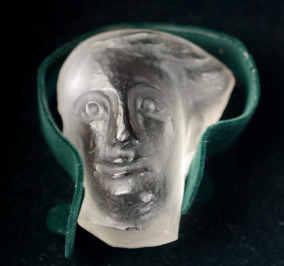A FINE GRAND TOUR GOLD BANGLE WITH A NEOCLASSICAL AGATE INTAGLIO. ALLEGORICAL SCENE. 19th century Stone 18x26 mm; int. Size 48x58 mm; 41,95 gr. PIERRET Ernesto (Born in Paris, 1824). A Gold bangle bracelet set with a large agate intaglio. Circa 1860 Of archaeological revival design, the oval intaglio, possibly a merchant’s seal, within a rope twist surround, two scrolls to either side, the bangle inscribed ‘SALVE’, translating s the Latin for ‘Hail’. The intaglio shows a Victory riding a quadriga to the left, on top an eagle holding a laurel wreath in its backs and thunderbolts in its paws. Beneath, portrait of a youth facing left, mouse inside a ring and grasshopper on ear of corns. Inscription retrograde ‘M.IVLI’. Ernesto Pierret was one of these jewelers. Born in Paris in 1824, Pierret moved to Rome in the 1840s, where he trained as a goldsmith. Historians speculate that he may have been apprenticed under Castellani, as Pierret's style was very similar to - and often compared to - the more popular Castellani. In 1846, Pierret opened his workshop. It was then that he began to build a reputation. The opening of his studio took place directly after his marriage to Virginia Crespi, the daughter of a wealthy lawyer. These family connections allowed him to move his studio to Rome's illustrious jewelry and artist district, where Pierret began to prosper. Provenance: U.K. private collection acquired on the art market.
A FINE GRAND TOUR GOLD BANGLE WITH A NEOCLASSICAL AGATE INTAGLIO. ALLEGORICAL SCENE. 19th century Stone 18x26 mm; int. Size 48x58 mm; 41,95 gr. PIERRET Ernesto (Born in Paris, 1824). A Gold bangle bracelet set with a large agate intaglio. Circa 1860 Of archaeological revival design, the oval intaglio, possibly a merchant’s seal, within a rope twist surround, two scrolls to either side, the bangle inscribed ‘SALVE’, translating s the Latin for ‘Hail’. The intaglio shows a Victory riding a quadriga to the left, on top an eagle holding a laurel wreath in its backs and thunderbolts in its paws. Beneath, portrait of a youth facing left, mouse inside a ring and grasshopper on ear of corns. Inscription retrograde ‘M.IVLI’. Ernesto Pierret was one of these jewelers. Born in Paris in 1824, Pierret moved to Rome in the 1840s, where he trained as a goldsmith. Historians speculate that he may have been apprenticed under Castellani, as Pierret's style was very similar to - and often compared to - the more popular Castellani. In 1846, Pierret opened his workshop. It was then that he began to build a reputation. The opening of his studio took place directly after his marriage to Virginia Crespi, the daughter of a wealthy lawyer. These family connections allowed him to move his studio to Rome's illustrious jewelry and artist district, where Pierret began to prosper. Provenance: U.K. private collection acquired on the art market.














Testen Sie LotSearch und seine Premium-Features 7 Tage - ohne Kosten!
Lassen Sie sich automatisch über neue Objekte in kommenden Auktionen benachrichtigen.
Suchauftrag anlegen